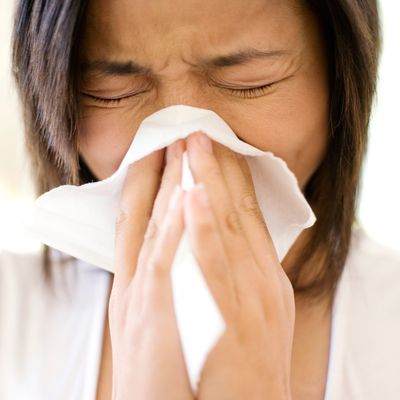
Allergy season is always awful. But according to Weather.com, this season will be one of the worst ones ever. It turns out that the long, miserable winter fertilized the ground and guaranteed vibrant spring plant life. This means more pollen, grass, and ragweed floating through the air.
To find out the best ways to fight the season’s sneezing, runny noses, and demon-red eyes, the Cut spoke with allergist/immunologist Dr. John Basso, who explained that to make allergy season somewhat tolerable, you need to act quickly.
1. Start nasal sprays immediately. Seriously. Though you may cringe at the thought, Dr. Basso says that corticosteroid sprays (a class of drugs that targets inflammation, among other conditions) are the most effective treatment for nasal allergy symptoms, but they take one to two weeks of consistent use to begin working. What’s worse, the later into the allergy season you begin using them, the less pollen it takes to trigger allergic symptoms like sneezing or a runny nose. It’s known as the priming effect, and it’s a doozy. Try Nasocort’s Allergy 24 Hour Spray now.
2. Air-conditioning is your friend. Filters are more than just delightful Instagram tools: The filters in air-conditioning units also block grass, pollen, and ragweed from entering your home.
3. Invest in an allergy window screen. No air-conditioning? Window screen filters thwart common seasonal-allergy irritants from entering your place. You’ll get the benefit of fresh air, though you will also face the soul-crushing reality of opaque screens that block your view of the outdoors. Still, as a bonus, you’ll save on curtains?
4. Or better yet, a nose screen. Nasal filters block airborne allergens — but your companions may think you have two giant boogers up your nose.
5. Rinse away your allergies. For mild sufferers, Dr. Basso recommends a saline rinse, which removes pollen, mucus, and other irritants from the nose. Try NeilMed’s Sinus Rinse.
6. Pull an Empire and drip drop. Eye drops, that is. Senior beauty editor Kathleen Hou is partial to Visine’s Eye-Allergy Relief. Or you can try Japanese and Swiss eye drops for whiter eyeballs.
7. As a last resort, pop an antihistamine. Antihistamines are only mildly effective at treating allergy symptoms. If you’re in a pinch, consider Allegra’s Allergy 12-Hour Non-Drowsy Tablets while your symptoms persist.
8. Get a leg up on next year with allergy shots. Immunotherapy (allergy shots) takes three to six months to start working and is the only treatment that modifies how allergic we are, says Dr. Basso. But it’s also a huge time commitment. If you undergo the treatment, expect weekly trips to the doctor for a series of starter dose shots; after three to six months, the dose schedule will reduce to biweekly or monthly for four or five more months. After that, your doctor will determine how often you should return for maintenance shots.





